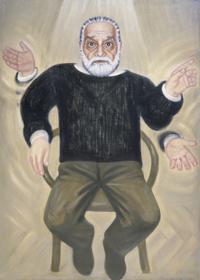Hi Ivan!
On the work of Ivan Sobotka with Věra Nováková in The Ztichlá klika Gallery, March 14, 2024
A year ago, the painter Věra Nováková (17 January 1928 - 30 March 2024) was still with us. We were forced to postpone the meeting at the Ztichlá klika Gallery due to her health issues. In the end we met thanks to the patience of the antiquarian and gallery owner Jan a Oscar Placák, Věra's daughter Kateřina Trlifajová and especially Věra herself. Until the very end, Věra was unbelievably energetic and inquisitive, even though she was already very ill. Her unmistakable inner beauty and deep strength were reflected in her external appearance. She loved life and, in a Christian way, even those who made it difficult for her. In the early 1950s, her husband Pavel Brázda managed to capture her charm in his portrait “Věra with Painted Wings”. There are many among us who know she had them.
“I can hardly see you, it’s like you were in a fog,” she said by way of greeting, and it was clear that she was going to be using her inner sight. We gathered over the early work of her friend, the painter Ivan Sobotka (February 4, 1927 - July 23, 2008). Ivan, Věra and Pavel Brázda were connected through art and humaneness. They studied together at the Academy of Fine Arts in Vladimír Sychra's studio until the communist purges in the late 1940s, which resulted in Pavel (because of his bourgeois origins) and Věra (who had good origins but was Pavel's girlfriend and that was enough) being thrown out by their comrades. Ivan wanted to show solidarity and get himself fired too, but in the end “fortunately”[1] (VN) he did not do it for family reasons. The three of them never ceased to see each other in pubs and “they kept on talking about shit”[2] (VN). One day Ivan reportedly arrived saying that he was disgusted with their existential disgust. Ivan and Věra found a way out in Christianity.[3] In contrast, Pavel doubted God, and his hominism reflected the absurdity of human existence. This is also why Věra referred to her marriage to Pavel as an “adventure of opposites”.
Ivan Sobotka's work has impressed Jan Placák since the Bolshevik era. Pavel, Věra and Ivan could not or would not exhibit publicly until 1989, with a few exceptions. In the summer of 1988, at an exhibition of the Union of Czech Artists in the Julius Fučík Park of Culture and Recreation, in short, in the Fučikárna, Jan Placák noticed Ivan Sobotka's paintings for the first time. When he later visited Ivan Sobotka at his studio at home, he was intrigued by the older works from the 1940s and 1950s. At that time, they were lying in a closet, and the gallerist convinced Sobotka to lend them to him and have part of them restored and exhibited. They became friends.
Judging by the accounts of Jan Placák, Věra Nováková and Sobotka's notes,[4] Ivan was a pedant and demanded strict order. He passed very unambiguous judgments and towards the end of his life he hated almost everyone. This also applied to fellow artists. He considered Zrzavý to be a bastard, but most of all he “shat on Kolář and Boštík” IS.[5] Once Pavel Brázda related with enthusiasm how Ivan said about him that he robbed little-known medieval illuminations, but he always fucked them up so much that they resulted only in Brázda.[6] The two of them gradually parted ways in their opinions, stopped seeing each other, but respected each other to the end.
Although Ivan Sobotka rejected most of the things he liked in the final years of his life, until his death he was said to have appreciated the painters Pierre Bonnard, Giorgio Morandi, Antonín Sládek and, oddly enough, the Dadaists Raoul Hausmann and especially Hugo Ball. Hugo Ball may have scoffed at traditional values in the early days of Dadaism, but a few years later he returned to Catholicism and realized that even his Dadaist sound poems were based on his experience in the church of his hometown, where as a boy he had served as an altar boy and listened to the sonorous Latin.
You can listen to a recording of a meeting with Věra Nováková on the work of Ivan Sobotka from 14 March 2024. Věra, her daughter Kateřina and Jan Placák informally reminisced about their friend Ivan and his wife Eva Sobotková. Please excuse the sometimes poor quality of the recording - it was a free-flowing encounter for the pleasure of the painter, who kindly agreed to allow us to record and publish part of it. The meeting was documented photographically by Jindřich Mynařík. Sobotka's drawings and “sketch paintings”, some of which are published for the first time, were reproduced by Ondřej Přibyl. The reproductions of Ivan Sobotka's works presented here are often untitled and undated - I have arranged them chronologically based on my own estimates.
Soon after her visit to the Ztichlá klika Gallery, on Holy Saturday, March 30, Věra departed, joining Ivan in eternity. If she had met him here on earth after so long, she would probably have thrown her arms around his neck and given him a big kiss without hesitation. God knows how such a meeting goes in the hereafter. What we do know is that alongside the ever-worsening news, good news remains, even if it may be on the fringes for now. I have chosen one of such piece of news from Ivan Sobotka: Why are you complaining? "The whole world is full of music and art. And books, actors and films. The whole world is one big work of art."[7] You will find more good news in the legacy of Věra Nováková and Ivan Sobotka.
Pavlína Bartoňová, March 14, 2025
(Translation Craig Cravens)
[1] Meeting with Věra Nováková and Pavel Brázda, summer 2017
[2] Ibid.
[3] They were strongly influenced by the writings of “Sorokin,” whom Věra Nováková mentions in an audio recording. This was the Russian-American sociologist, theorist of culture and Masaryk’s favorite Pitrim Sorokin and his book The Crisis of our Age.
[4] Ivan Sobotka, Argo, GASK 2012
[5] Ibid, p. 10
[6] Meeting with Věra Nováková and Pavel Brázda, summer 2017
[7] Ivan Sobotka, Argo, GASK 2012, p. 10




